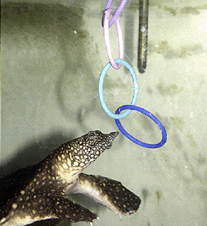Invasive “alien” species (IAS) are essentially organisms that, whether through direct release or incidental occupation, find themselves in the wrong place. There are lots of these non-natives out there – according to the Intergovernmental Science-Policy Platform on Biodiversity and Ecosystem Services at least 37,000 invasive animals and plants exist worldwide, with about 200 being added each year, and more than 3,500 IAS are recorded as threats to nature. Estimates suggest that over 7,780 vertebrate species are traded globally, with over 800 recognised as invasive wildlife (Li et al., 2023). The fact that exotic pets constitute a large part of such alien vertebrates is a major concern.
Estimates suggest that over 7,780 vertebrate species are traded globally, with over 800 recognised as invasive wildlife
Consequently, around 80 percent of countries now have action plans for dealing with non-native species. Control measures may reach above 60 percent success in some cases (notably for plants and invertebrates), although frequently such efforts amount only to holding back the tide, and at an estimated cost of $423 billion a year globally (IPBES, 2023). How often is that cost factored into the “economic benefits” of wildlife trade? Moreover, invasive animal eradication programmes come at the arguably even greater cost of welfare, which, for the most part, isn’t pretty.
Going native
It is surely rough enough that wild animals are either wrenched from their homelands or incarcerated and bred in typically depauperate conditions in order to satisfy a human cultural curiosity, and where most will likely experience unnatural morbidity and high premature mortality. On escape or release, they might face additional hardships as they occupy unfamiliar environments, where they either perish in an unsuitable climate and ecology or, if “lucky”, adapt to survive. However, once re-established back in the wild, their treatment by humans is no place like home, and these same victims of one or another form of fashion find themselves reclassified as pests and relentlessly pursued until death. With so many invasives most definitely “out there”, a few choice examples will just have to do.
Their treatment by humans is no place like home, and these same victims of one or another form of fashion find themselves reclassified as pests and relentlessly pursued until death
| Did you know we offer CPD membership plans? Get access to thousands more articles, hundreds of short courses and easily fulfil your annual CPD requirements. Find out more here. |
A price on their heads
Toad haul
A commonly cited example of an invasive species is the infamous cane toad of Australia, which was deliberately introduced from South America in the 1930s to control an indigenous sugar-cane-eating “pest” beetle – inviting a would-be pest to control a pest. What genius thought that a giant toad would only consume a beetle is anyone’s guess. That said, the same level of moronic ingenuity appears to have founded the century-long cull, which despite some fluffy and false talk around “humane killing” has actually meant freezing, gassing, shooting, stabbing, crushing and burying alive millions of toads – yet some 200 million may still occupy the continent.
Green on blue
In the Cayman Islands, the green iguana, introduced three decades ago by the pet trade, outcompeted its indigenous blue cousin to the point where the lizards could be seen almost everywhere basking in trees or scurrying through bushes. That was until the regional government – allied to Britain’s very own Defra – put up £8.6 million to put them down. The cull was hardly a dignified veterinary intervention, but instead a payment to anyone for killing hapless iguanas. Here, “killing” commonly means either poorly despatched by air-rifle or decapitated – neither process can be called humane. Because reptilian physiology is resistant to blood loss, victims may languish badly injured – and even their heads can remain conscious for up to an hour post-severance. Nevertheless, around 1.5 million iguanas have been brutally massacred, many of them for less than £5 a head – literally (Connolly, 2023).
Nevertheless, around 1.5 million iguanas have been brutally massacred, many of them for less than £5 a head – literally
Swamped with pythons
Burmese pythons are among numerous major IAS introduced into the USA by – yet again – the pet trade. Many have become apex-grade predators in Florida and elsewhere, and consume anything they can overpower, which are most animals. In Florida alone, there are estimated to be between 30,000 and 300,000 Burmese pythons (Leatherman and Leatherman, 2024). No surprises here: in comes the government to sanction paid – and typically inhumane – capture, handling and killing by a bunch of machete-wielding “swamp people”, who even get a TV show to celebrate their carnage, with such spectacles open to the public as part of python culling challenges.
Catastrophic for cats
But it’s not just the cold-blooded animals that the IAS hot-heads are after. In New Zealand, hundreds of cats have lost their lives in organised hunts during dystopian-like entertainment competitions. So, although not the only source of alien species, the commercial and private pet sectors wield a large and grubby paw while continuously reaping the rewards of trading and keeping animals, and others quite literally pick up the tab – and the pieces.
Cultural hypocrisy
The fact is, far and wide, many organisms become invasive species, and are often savagely demonised. That immoral mess arises through no fault of their own; the true fault resides entirely with cultural culprits such as the pet trade, irresponsible ownership, anthropocentric transportation systems which can deliver organisms anywhere overnight, and deficient regulation and enforcement.
The true fault resides entirely with cultural culprits such as the pet trade, irresponsible ownership, anthropocentric transportation systems which can deliver organisms anywhere overnight, and deficient regulation and enforcement
However, the same absolution cannot be offered to humans, who – whether through war, population expansion, habitat encroachment, resource acquisition and what many would generally call “progress” – persistently expand their realm of occupation within the natural world and on a global scale. Human-geological spread manifests to the unquestionable detriment of indigenous lifeforms and their ecologies in any vista. So, if one is to genuinely seek out and condemn the world’s most harmful invasive species, one does not have to look very far to see it.










